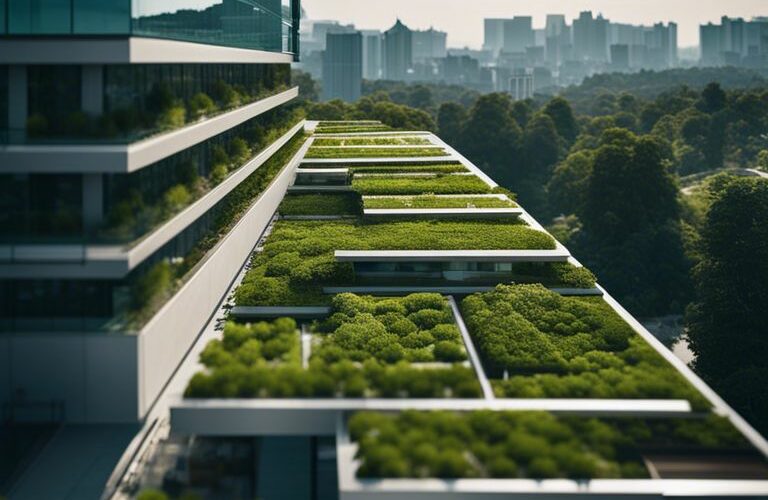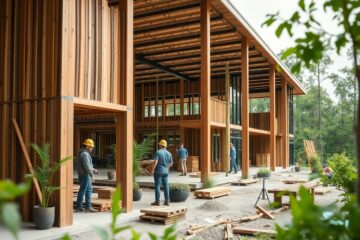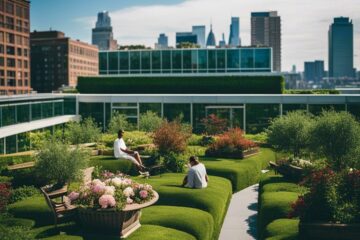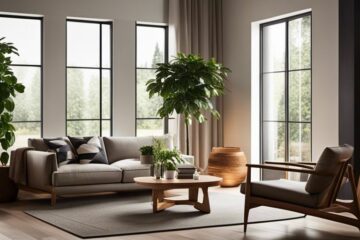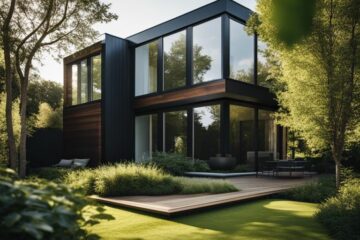Embarking on a journey to explore the intricacies of ecological building systems opens up a world of possibilities for a more sustainable and environmentally-friendly future. The use of eco-friendly materials and sustainable construction practices not only reduces the negative impact on our planet but also offers a plethora of benefits that extend far beyond the initial building phase.
Table of Contents
Key Takeaways:
- Reduction in Energy Consumption: Ecological building systems can significantly reduce energy consumption through improved insulation and ventilation, leading to lower utility bills.
- Healthy Indoor Environment: By using natural materials that are non-toxic and allergen-free, ecological building systems help create a healthier indoor environment for occupants.
- Environmental Sustainability: Eco-friendly building systems reduce the environmental impact of construction by using renewable resources, minimizing waste, and promoting energy efficiency.
- Enhanced Durability: Ecological building materials are often stronger and more durable than conventional materials, leading to longer-lasting structures and reduced maintenance costs over time.
- Improved Resale Value: Homes built with ecological building systems are increasingly valued in the market due to their energy efficiency, sustainability, and healthier living environments, which can lead to a higher resale value in the future.
Historical Context of Ecological Building
Obviously, understanding the historical context of ecological building practices provides us with invaluable insight into the foundations of sustainable construction.
Traditional vs Modern Building Practices
With the advancing industrialization, traditional building practices have gradually given way to modern construction techniques that often prioritize speed and cost over sustainability and environmental impact. Traditional building methods, such as using local and natural materials like adobe, timber, and straw, showcased a deep-rooted understanding of the environment and a harmonious relationship with nature.
In stark contrast, modern building practices rely heavily on concrete, steel, and other non-renewable resources, contributing to significant environmental degradation through carbon emissions, deforestation, and waste generation.
Evolution of Ecological Building
Building on the rich history of traditional practices, the evolution of ecological building has seen a resurgence in sustainable construction methods that prioritize energy efficiency, eco-friendly materials, and waste reduction. Embracing innovations like passive solar design, green roofs, and greywater recycling, these approaches aim to minimize environmental impact and create healthier living spaces for occupants.
By integrating modern technology with traditional wisdom, the evolution of ecological building seeks to strike a balance between innovation and sustainability, setting a new standard for construction practices that benefit both people and the planet.
Historical records demonstrate how our ancestors built with respect for nature, using resources wisely and creating structures that stood the test of time. This echoes a profound truth that we must not forget in our quest for progress – the importance of learning from the past to create a sustainable future.
Core Principles of Ecological Building Systems
If we want to build for the future, we must prioritize the core principles of ecological building systems. These principles are the foundation on which sustainable and environmentally friendly structures are constructed. By adhering to these principles, we can create buildings that not only meet our current needs but also ensure a more sustainable and resilient future for generations to come.
Sustainability in Material Selection
One of the fundamental principles of ecological building systems is the sustainability of material selection. When choosing materials for construction, it is essential to consider their environmental impact throughout their lifecycle. This includes factors such as extraction, manufacturing, transportation, installation, and disposal. Opting for materials that are renewable, recyclable, and locally sourced can significantly reduce the carbon footprint of a building.
Furthermore, incorporating green building materials such as bamboo, reclaimed wood, recycled glass, and low-VOC paints can enhance indoor air quality and promote a healthier living environment for occupants. By prioritizing sustainability in material selection, we can reduce waste, conserve natural resources, and minimize environmental degradation.
Energy Efficiency and Renewable Resources
Ecological building systems emphasize the importance of energy efficiency and the utilization of renewable resources. By incorporating design strategies such as passive solar heating, natural ventilation, and high-performance insulation, buildings can significantly reduce their energy consumption and carbon emissions. Additionally, integrating renewable energy sources such as solar panels, wind turbines, and geothermal systems can further enhance the sustainability of a structure.
Energy efficiency and renewable resources not only reduce the environmental impact of buildings but also offer long-term cost savings for owners. By investing in energy-efficient technologies and harnessing renewable resources, buildings can achieve greater independence from fossil fuels and contribute to a more sustainable energy future.
Water Preservation and Management
Core to ecological building systems is the principle of water preservation and management. Efforts to reduce water consumption, promote water recycling, and implement efficient irrigation systems are essential for sustainable development. By installing low-flow fixtures, rainwater harvesting systems, and greywater recycling systems, buildings can significantly decrease their water usage and lessen the strain on local water sources.
An integrated approach to water preservation and management involves not only reducing water consumption within buildings but also implementing sustainable landscaping practices that minimize water runoff and promote natural water filtration processes. By prioritizing water conservation, buildings can contribute to overall water sustainability and resilience in the face of climate change.
Health and Wellbeing Advantages
Keep in mind that the design and construction of a building can have a significant impact on the health and wellbeing of its occupants. By incorporating ecological building systems, we can create spaces that promote a healthier and more comfortable environment.
Improving Indoor Air Quality
Quality indoor air is essential for the health and wellbeing of building occupants. Ecological building systems focus on using materials and ventilation strategies that minimize harmful pollutants and improve air quality. This can help reduce the risk of respiratory issues, allergies, and other health problems associated with poor indoor air quality.
Quality air circulation systems, natural ventilation, and the use of low-emission materials are key components of ecological building systems that contribute to better indoor air quality. By prioritizing the health of occupants, these systems create a more comfortable and productive indoor environment.
Natural Light and Its Effects on Occupants
To enhance the health and wellbeing of occupants, ecological building systems often incorporate natural light as a key design element. Exposure to natural light has been shown to improve mood, increase productivity, and regulate the body’s circadian rhythms, leading to better sleep patterns and overall wellness.
A well-designed building that maximizes natural light can reduce the need for artificial lighting and create a more inviting and energizing space for occupants. By incorporating features like large windows, skylights, and light wells, ecological building systems can harness the benefits of natural light to enhance the overall quality of the indoor environment.
Economic Implications of Ecological Building
Long-Term Financial Benefits
Unlike traditional building systems, ecological building systems offer a range of long-term financial benefits. An initial investment in eco-friendly materials and technologies can lead to significant savings over time. Energy-efficient designs, such as passive solar heating and cooling, can dramatically reduce utility costs. Additionally, the use of sustainable materials can lower maintenance expenses and extend the lifespan of the building, saving money on repairs and replacements in the future.
Furthermore, ecological buildings often have a higher resale value than traditional structures. As society becomes more environmentally conscious, the demand for sustainable properties is increasing. This means that investing in an eco-friendly construction can offer financial returns in the long run, making it a sound economic decision.
Incentives and Rebates for Eco-friendly Construction
Rebates and incentives are available for those who choose to invest in eco-friendly construction. Many governments and municipalities offer financial incentives to encourage the incorporation of sustainable practices in building projects. This could include tax credits, grants, or rebates for using energy-efficient materials or installing renewable energy systems.
Ecofriendly construction can also help builders qualify for certifications such as LEED (Leadership in Energy and Environmental Design) which can further enhance the value of the property. These certifications not only validate the sustainability of the building but also can attract more environmentally conscious buyers or tenants, providing a competitive edge in the real estate market.
Architectural Innovations in Ecological Building
Nowadays, architects and designers are constantly exploring new ways to incorporate ecological principles into building design. This has led to a wave of architectural innovations aimed at creating more sustainable and environmentally friendly structures. These innovations not only help reduce the impact of construction on the environment but also contribute to the well-being of those who inhabit these spaces.
Green Roofs and Living Walls
One of the most striking architectural innovations in ecological building is the integration of green roofs and living walls. Green roofs are vegetated layers on top of buildings that provide a range of benefits including improved insulation, reduced energy costs, and enhanced stormwater management. Living walls, on the other hand, are vertical gardens that not only improve air quality but also provide a natural aesthetic to the building.
For architects and designers, incorporating green roofs and living walls into building designs requires careful planning and implementation. They need to consider factors such as structural support, irrigation systems, and plant selection to ensure the longevity and effectiveness of these features. Additionally, maintenance plans must be put in place to ensure that these green elements continue to thrive over time.
Biomimicry in Design and Material Use
For architects looking to push the boundaries of ecological building, biomimicry offers a wealth of inspiration. This design approach involves looking to nature to draw ideas for sustainable design solutions and material use. By studying the way natural systems work, architects can create buildings that function more efficiently and harmoniously with the environment.
With biomimicry, architects can design buildings that are not just environmentally friendly but also highly functional and innovative. From using biomimetic materials that mimic natural processes to designing structures that imitate the efficiency of natural systems, there is no shortage of possibilities when it comes to incorporating nature-inspired solutions into building design.
Case Studies of Successful Ecological Building Projects
To truly understand the benefits of ecological building systems, we must look at real-life examples of successful projects that have implemented sustainable practices. These case studies serve as a testament to the effectiveness of eco-friendly building techniques in creating environmentally conscious structures.
- 1. The Earthship Community in Taos, New Mexico: This sustainable housing development consists of off-grid homes built from recycled materials, utilizing solar power and rainwater harvesting systems.
- 2. The Bullitt Center in Seattle, Washington: This commercial office building is designed to be self-sustaining, generating all its energy from solar panels and capturing rainwater for all its water needs.
- 3. The EDGE Olympic in Munich, Germany: An eco-friendly residential building that meets the highest standards of sustainability, with features like green roofs, triple-glazed windows, and energy-efficient appliances.
Residential Success Stories
On the residential front, projects like the Earthship Community and the EDGE Olympic showcase the possibilities of sustainable living. These innovative designs not only reduce environmental impact but also provide comfortable and healthy living spaces for residents.
By incorporating renewable energy sources, recycled materials, and energy-efficient technologies, these buildings demonstrate that eco-friendly practices can be seamlessly integrated into residential construction without compromising on quality or comfort.
Commercial and Public Building Projects
Studies have shown that eco-friendly commercial and public buildings, such as the Bullitt Center, can significantly reduce operational costs and carbon footprints. By investing in solar power, green infrastructure, and energy conservation measures, these projects not only benefit the environment but also lead to long-term financial savings for owners.
Projects like the Bullitt Center serve as inspirational examples for the construction industry, demonstrating that sustainable design is not only feasible but also economically viable in the long run. By prioritizing environmental responsibility, these buildings set a new standard for future developments.
Barriers and Challenges in Ecological Building
Regulatory Hurdles and Zoning Laws
Hurdles often arise when attempting to implement ecological building practices due to regulatory hurdles and zoning laws that favor traditional construction methods. Many regions have strict building codes that do not account for the benefits of sustainable building materials and practices. This can make it difficult for architects and builders to incorporate environmentally-friendly systems into their designs.
Additionally, zoning laws can restrict the use of certain construction materials or limit the types of structures that can be built in specific areas. These restrictions can hinder the adoption of ecological building practices and limit the potential for sustainable development.
Overcoming Misconceptions and Educational Gaps
Building for the future requires overcoming misconceptions and educational gaps surrounding ecological building. Many individuals may be hesitant to embrace new construction methods due to a lack of understanding or misinformation about the benefits of environmentally-friendly materials and systems. Educating the public about the advantages of ecological building is crucial in overcoming these barriers.
For instance, some may believe that ecological building is more expensive or less structurally sound than traditional construction methods. However, research has shown that sustainable building practices can actually reduce long-term costs and create structures that are durable and resilient in the face of environmental challenges.
Looking Toward the Future
Not only do ecological building systems benefit the environment, but they also offer long-term advantages for homeowners and communities. By incorporating sustainable materials and practices, we can create a more resilient and healthier built environment for future generations.
Emerging Technologies in Eco-building
The rapid advancements in technology are revolutionizing the field of eco-building. Innovations in green construction now include the use of smart technologies, such as sensors for energy efficiency monitoring and renewable energy systems like solar panels and geothermal heating.
These technologies not only reduce carbon footprint but can also lead to significant cost savings for homeowners in the long run.
The Role of Policy and Advocacy in Supporting Ecological Building
For ecological building practices to become more widespread, support from policymakers and advocates is crucial. Governments can incentivize green building certifications, offer tax breaks for sustainable construction, and enforce stricter regulations on energy efficiency standards.
Advocacy organizations play a key role in promoting sustainable building practices and educating the public on the benefits of eco-friendly construction.
Summary of Ecological Building Benefits
Ecobuilding offers a wide range of benefits, including improved indoor air quality, reduced energy costs, and lower carbon emissions. By using sustainable materials and energy-efficient design, eco-buildings contribute to a healthier and more sustainable future.
The Path Forward for Ecological Building Systems
Emerging trends in ecological building systems point towards a future where sustainability is the norm rather than the exception. By integrating green technologies and advocating for supportive policies, we can create a built environment that is truly sustainable for generations to come.
FAQ
Q: What are ecological building systems?
A: Ecological building systems are sustainable construction methods that prioritize environmental and human health, using materials and techniques that have minimal impact on the planet.
Q: What are the benefits of using ecological building systems?
A: Using ecological building systems can reduce energy consumption, lower carbon emissions, improve indoor air quality, and create healthier living spaces for occupants.
Q: How do ecological building systems contribute to sustainability?
A: Ecological building systems promote sustainability by using renewable resources, reducing waste, and minimizing the environmental footprint of buildings over their lifecycle.
Q: What are some examples of ecological building systems?
A: Examples of ecological building systems include green roofs, passive solar design, natural ventilation, recycled materials, and energy-efficient appliances.
Q: How can individuals incorporate ecological building systems into their own projects?
A: Individuals can incorporate ecological building systems by choosing eco-friendly materials, energy-efficient design strategies, and sustainable practices during the construction and maintenance of their buildings.

Our contributing author is a passionate advocate for eco-friendly living and sustainability. With a background in eco-life, they are dedicated to inspiring and empowering individuals to adopt environmentally conscious lifestyles. Through insightful articles, they share practical tips, innovative solutions, and thought-provoking perspectives to promote a greener, more sustainable world. Join them on the journey towards eco-smart living and discover how small choices can make a big impact. 🌱

